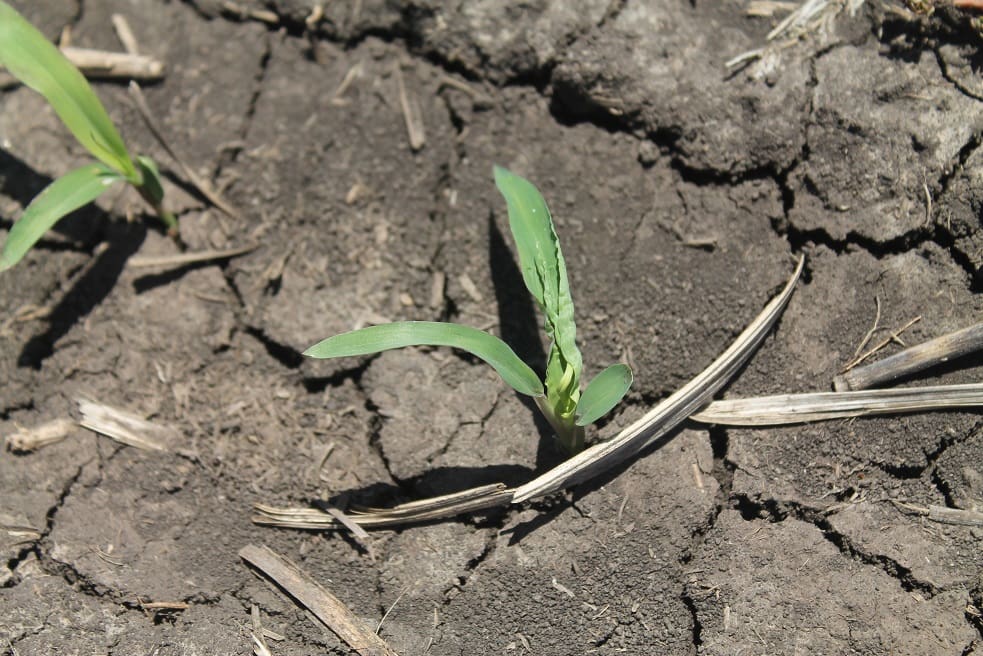
Sorghum seedling exhibiting symptoms of pre-emergent herbicide damage (S-metolachlor, in association with short term waterlogging). (Photo: M. Congreve)
Ask a WeedSmart Expert
Resistance to glyphosate and to a range of post-emergent herbicides is driving the increased use of pre-emergent herbicides in Australian cropping systems, but getting a good result with these herbicides is not always straightforward.
To assist growers and agronomists, The University of Adelaide weed management professor, Dr Chris Preston, and Independent Consultants Australia Network (ICAN) senior consultant, Mark Congreve, have shared their expertise in the online Diversity Era course ‘Pre-emergent Herbicides 101’.
“In the southern farming systems, resistance to in-crop herbicides has been the main driver for the increased use of pre-emergent herbicides,” Dr Preston said.
“When pre-emergent herbicides are used to provide early weed control in a competitive crop, the amount of weed seed set in-crop can be vastly reduced.”
In northern cropping systems the main driving force for increased use of pre-emergent herbicides is found in the fallow periods where a rapid increase in glyphosate resistant and glyphosate tolerant weeds in the last five years leaves no-till farmers with few weed control options.
“Northern growers are looking to add pre-emergent herbicides to their fallow management program and cotton and sorghum growers are using lay-by applications of pre-emergent herbicides to control weeds in the inter-row,” Mr Congreve said.
“The use of pre-emergent herbicides in these situations requires extra care and planning to avoid crop damage and to keep future cropping options open.”

Presenters Mark Congreve and Dr Chris Preston with WeedSmart extension agronomist Peter Newman deliver the Pre-emergent herbicides 101 course.
Are there different pre-emergent herbicides suited to different situations?
Short answer: Yes. A key difference between pre-emergent herbicide products is their mobility in the soil, which is largely driven by soil type, chemical solubility and level of absorption to soil and organic material.
Longer answer: All pre-emergent herbicides need to reach the soil and create a band of treated soil around the weed seeds to reduce germination. In high stubble situations, and especially where the stubble is laying flat on the soil surface, the first challenge is to get the herbicide through the stubble layer and into the soil. Some herbicides wash off stubble better than others. Products like trifluralin are generally not an effective option in high stubble situations.
In very high residue years growers may decide to burn paddocks prior to sowing and applying pre-emergent herbicide. The herbicide will not bind to the ash, but sometimes there is a layer of chaff left after a stubble burn, and this can still be a barrier to the herbicide reaching the soil.
Once in the soil, some pre-emergent herbicides move more quickly down the profile than others. For example, S-metolachlor (one component of Boxer Gold) and Sakura both have a ‘medium’ rating for binding to soil and organic matter, but quite different solubility ratings. S-metolachlor is reasonably soluble and reaches the weed seeds in the topsoil easily, while Sakura has low solubility, which can mean that in dry years the herbicide might not reach some deeper weed seeds before they germinate.
However, in high rainfall zones or in wet years s-metolachlor is likely to move further horizontally and vertically in the soil profile, increasing the likelihood of coming into contact with the crop seed.
What else do I need to have in place to support pre-emergent herbicides in-crop?
Short answer: Crop competition, harvest weed seed control and double breaks all help make the most of pre-emergent herbicide applications.
Longer answer: Relying on pre-emergent herbicides only is not a good idea in weedy situations. If weed numbers are high it is essential to reduce the weed seed bank using other tactics first. Pre-emergent herbicides are most effective when used to provide early weed control in competitive crops where the crop itself can further suppress weed growth and seed set later in the season.
The extensive and long-term use of in-crop herbicides in southern grains regions has selected for longer dormancy in weeds like annual ryegrass. As a result, growers can make significant gains through sowing early into warmer soils to promote vigorous early crop growth and using a pre-emergent herbicide either incorporated by sowing or, for certain herbicides, applied soon after planting. If soil conditions are warm and moist at sowing it is very important to incorporate the herbicide quickly and realise that microbial degradation can be more rapid in this situation, making strong crop competition even more important.
How does chemical degradation impact on pre-emergent herbicides when used in a summer fallow?
Short answer: Pre-emergent herbicides primarily degrade, or ‘run out’, due to microbial breakdown in the soil. Photodegradation (UV light exposure), volatilisation, leaching and hydrolysis may also be significant loss pathways for certain herbicides.
Longer answer: Soil temperature and moisture are the key drivers for microbial degradation of pre-emergent herbicides. These factors need to be considered as a risk when using pre-emergent herbicides with long plant back periods and the possible impact on rotational crop options if there is insufficient rainfall to allow breakdown of the herbicide.
On the other hand, some pre-emergent herbicides applied soon after harvest may not provide full-season fallow weed control in high rainfall years.
The frequent use of a single pre-emergent herbicide may favour the build-up of the suite of microbes that degrade that herbicide. Over time, pre-emergent herbicide efficacy can ‘run out’ quicker than it did when it was first used.
When applied in a no-till fallow, the pre-emergent herbicide may sit on the soil surface for a period of time awaiting rainfall for incorporation. To minimise losses due to UV light and volatilisation it is important to follow the label instructions for the timing of incorporation by rainfall, irrigation or tillage.
Source: WeedSmart
WeedSmart’s ‘Diversity Era Pre-Emergent Herbicides 101’ course can be completed in less than 10 hours, giving you a solid grounding in the basics of how pre-emergent herbicides work and how to get the best results in winter and summer cropping systems.
You will find the free, online Diversity Era Pre-emergent Herbicides 101 course at www.diversityera.com/courses/pre-emergent-herbicides-101
…………………………………………………….
How to ask a WeedSmart question
Ask your questions about using pre-emergent herbicides on the WeedSmart Innovations Facebook page WeedSmartAU, Twitter @WeedSmartAU or the WeedSmart website www.weedsmart.org.au/category/ask-an-expert/
‘WeedSmart’ is an industry-led initiative that aims to enhance on-farm practices and promote the long term, sustainable use of herbicides in Australian agriculture.
Grain Central: Get our free daily cropping news straight to your inbox – Click here



HAVE YOUR SAY